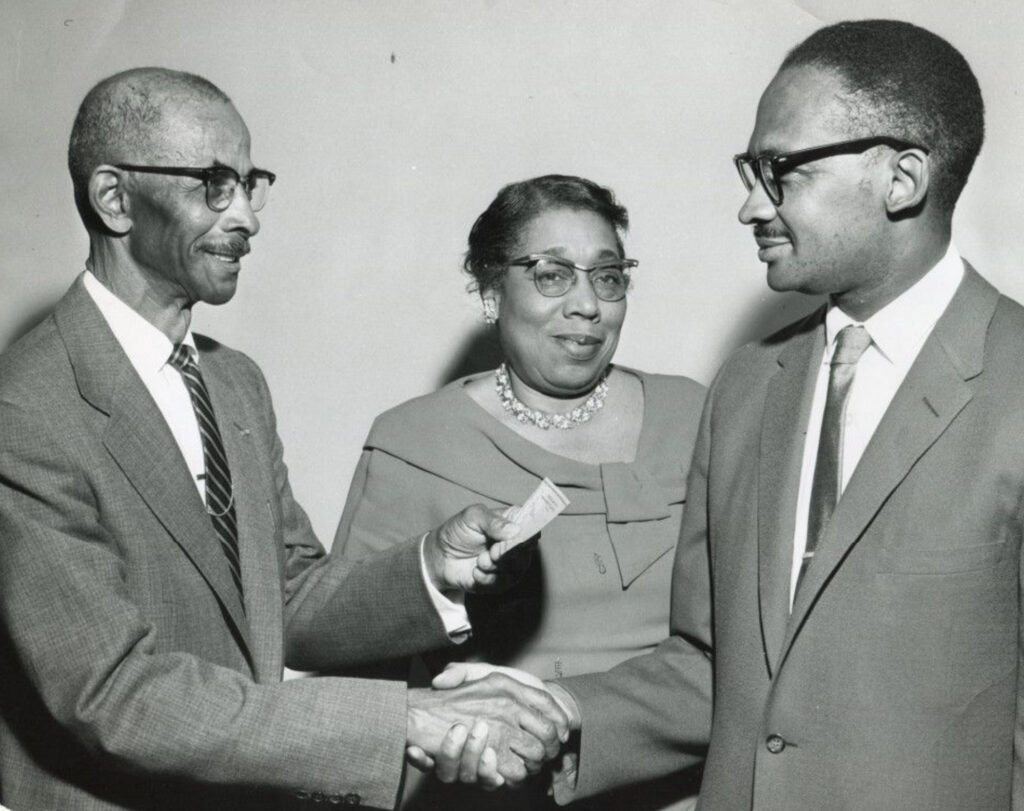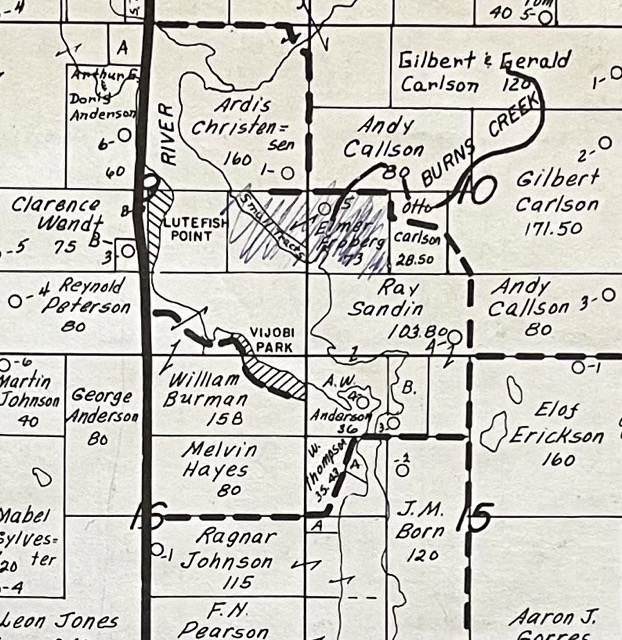In searching for Addie Clinton Few’s summer cottage, I couldn’t help but wonder- Is it Lutefish or Lutefisk Point? Looking back through maps and newspaper articles it is called both. Today the land along the Apple River, one mile north of Cameron Bridge in Lincoln Township, is Lutefisk Point. However, in the 1950s, it was referred to as Lutefish. In my work, I notice these inconsistencies constantly and it adds to the mystery of how the land has evolved over time. To watch property lines shift and shrink like ice, to see the names of landowners change and stay the same, and to learn the histories of the people who lived here is why I do what I do. Oftentimes, it’s the latter leading me to old plat books and even sometimes to emails and calls with Polk County’s Department of Land Information. I noticed Addie C. Few’s name in the Social and Personal column of the June 22nd St. Paul Recorder from 1956, “Addie Few spent a delightful weekend fishing, taking boat rides, playing Pinochle, talking pictures, and last but not least, eating.” The column went on to detail a weekend spent at her summer home with her Pinochle club and from there, I knew I needed to learn Addie’s story.
Addie C. Few was a prominent midwestern civil rights activist, President of the St. Paul Branch of the NAACP, and resident of St. Paul’s Rondo Neighborhood has a compelling connection to Polk County. She was born in 1882 on the Skinner Plantation in Waynesboro, Georgia, where her father, Isaiah Clinton, worked as an overseer. After Mr. Skinner was struck by lightning, his wife sold the plantation to her father, a Black man, in the Post-Reconstruction era south. In 1909, Addie traveled to the Tuskegee Institute in Alabama and studied to become a nurse. Booker T. Washington was the founder and president of the school, where he urged students to “get an education. Get a job, and save your money. Then own a piece of land.” Addie graduated in 1913 before traveling north in search of opportunity- first to Illinois and then to Minnesota. “I had graduated from the nurse’s training course at Tuskegee Institute. Then I decided to leave the south for Minnesota – which we considered the land of the free. But I discovered nobody here has ever heard of a [Black] nurse.”
“In St. Paul, I was far north, but the prejudice was worse than in the south,” Mrs. Few said. The Ramsey County Hospital refused to register her as a nurse. Addie sold her house in Waynesboro, bought property in St. Paul, and opened a mechanics garage in 1925. Addie became active in the NAACP the same year and married a Northern Pacific Railroad dining car porter, John Crawford Few. Through the years, she invested any extra money she made in property, including a home at 643 Iglehart Avenue in St. Paul’s Rondo neighborhood and a summer cottage in Amery, WI, in the 1950s.
Addie’s cottage was located along a wide section of the Apple River. She purchased the property at Lutefisk Point in 1954. The social columns referred to it as “Clinton’s Retreat” and “Few’s Retreat” depending on the year. Throughout the 1950s and 1960s, Addie opened her summer home to visitors from all over the country and social and civic clubs from the Rondo neighborhood. Throughout her lifetime, Addie belonged to ten civic clubs and was committed to social justice and the struggle for civil rights. Clinton’s Retreat hosted multiple meetings of the Breakfast Pinochle Club. Weekends at Addie’s summer cottage were full of fishing, swimming, taking pictures, boating, fish fry, and barbecuing. The cottage was located only one mile from what once was “Camp DuGhee”, the summer home Fredrick L. McGhee, Minnesota’s first Black attorney and one of the founders of the NAACP. McGhee and another early civil rights visionary, W.E.B. Du Bois, vacationed at Camp DuGhee during the early 1900s.

Addie C. Few, President of the St. Paul NAACP, celebrates Dr. Alexander Abram’s lifetime membership with C.S. Anderson in 1960. Photo courtesy of the Hallie Q. Brown Community Center Archives.
In an uncanny parallel to their fight for justice and equality, Addie served as a board member, Vice President, and President (1959-62) of the local branch of the NAACP. She was the second woman in the history of St. Paul to serve as President and was instrumental in organizing the 1960 NAACP National Convention. Much of her activism and energy was spent fighting urban redevelopment projects that displaced Black families in St. Paul, like the construction of Interstate 94 through Rondo.”All of our problems are centered on housing. Some of our schools are almost segregated because [we] are confined to certain sections of the cities.”
These are of course only some aspects of Addie Few’s incredibly full life. Her story transcends the Rondo neighborhood, Minnesota, and ventures into Polk County as a place of respite and relaxation like so many others.
Sources
- Star Tribune, January 19, 1960, 7.
- “Addie Found the Answer Late but Not Too Late,” Awake!, July 22, 1994, 23. https://wol.jw.org/en/wol/d/r1/lp-e/101994525
- Minneapolis Spokesman, July 2, 1954, 1.
- Minneapolis Spokesman, October 14, 1960, 5.
- St. Paul Recorder, June 22, 1956, 3.
- St. Paul Recorder, January 15, 1960, 1.
- Star Tribune, January 19, 1960, 7.


Recent Comments